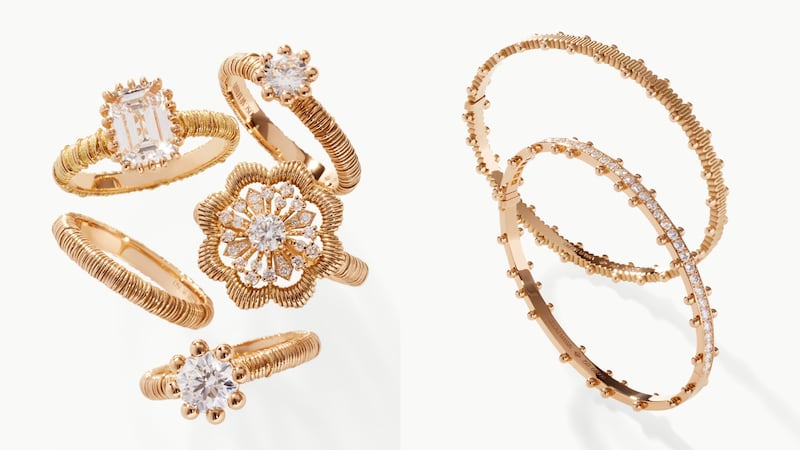
The Business of Fashion
Agenda-setting intelligence, analysis and advice for the global fashion community.

Agenda-setting intelligence, analysis and advice for the global fashion community.

Can a 160-year old high jeweller be brought back to life for a new generation of conscious consumers? A team of former executives at the industry’s biggest names believes so.
Frédéric de Narp, the former CEO of Swatch Group’s Harry Winston, and Coralie de Fontenay, a longtime executive at Richemont’s Cartier, have teamed up to relaunch Oscar Massin, a 19th-century high jewellery maker known for his innovative diamond-setting techniques and intricate trompe-l’oeil creations.
While the Massin name has largely disappeared from view since its founder’s death in 1923, the new team is betting there’s space in the fast-growing luxury jewellery market to revive the heritage brand, this time with an emphasis on sustainability and ethics.

Launched in 1863, Oscar Massin won illustrious clients and the respect of the industry thanks to its founder’s unique techniques for setting diamonds in flexible surfaces. That allowed for designs that mimicked lace or ribbons, and tiaras where stones vibrated along with the wearer’s movements, generating unprecedented sparkle. Important pieces include the Fife Tiara housed in Britain’s Kensington Palace, and a crown designed for French Empress Eugénie to display the country’s 140 carat Regent diamond. At the 1867 World’s Fair, Massin cheekily displayed his signature lace and ribbon designs for sale by the metre, as if in a sewing shop.
ADVERTISEMENT
More recently, Massin became an intriguing presence on the Met Gala red carpet, where Vogue editor-in-chief (and the party’s host) Anna Wintour wore a gleaming antique diamond necklace by the designer in both 2019 and 2021.
De Narp and De Fontenay founded the investment fund Luximpact last year with the aim of rebooting legacy jewellery brands with only lab-grown and non-virgin materials, adapting the codes and traditions of French luxury to a new generation’s values.
After discovering the dormant Massin, the duo searched for surviving heirs to the long-defunct trademark. Finding none, they registered it for themselves in key markets worldwide, and partnered with designer Sandrine de Laage, a former creative director of Harry Winston and studio director at Cartier, to create the brand’s first collection in a century.

De Laage paid homage to Massin’s prowess in constructing jewellery by highlighting the settings as a decorative element, rather than hiding them behind the stones. In her collection, beaded settings grip the stones from the outside, like a frog’s foot. In other pieces, she evokes Massin’s interest in imitating cloth, with recycled gold bracelets moulded to resemble circled ropes or spools of wrapped thread.
Luximpact’s Massin relaunch comes on the heels of an operation to revive Vever, a key player in Art Nouveau jewellery known for its fanciful organic shapes and intricate enamel work. LuxImpact’s team (including designer De Laage) partnered with the brand’s 7th generation heirs, Camille and Damien Vever, to create a high jewellery collection for the brand last summer.
After selling out that debut collection featuring enamel fairy motifs through one-to-one appointments with collectors, Vever launched an e-commerce platform for its fine jewellery and bridal ranges, and is currently is preparing to open its first physical location: a shop-in-shop at Paris’ Printemps department store.
“We want to give life to these precious brands, while redefining the codes of the industry,” De Narp said.
For Massin, Luximpact is opting to launch first in the US, the world’s biggest diamond market, and where demand for lab-grown stones is widespread. The brand partnered with a Washington, DC-based provider of lab-grown stones, Latitude Diamonds, and partnered with a New York jewellery workshop to produce the collection. An e-commerce launch is slated for mid-February, followed by physical activations planned later this spring in both New York and LA.
ADVERTISEMENT
The initial fine jewellery range has an average price of around $4,500. A top-end haute joaillerie range aimed at collectors is set to follow in June.

As the luxury industry boomed in recent years, attempts to relaunch defunct houses have become commonplace in the fashion and leather goods space, where the likes of Schiaparelli, Carven, Poiret, Poitou and Moynat have all been revived at great expense with limited success, sparking intrigue but often struggling to commercialise their glamorous legacies in the crowded fashion space.
Luximpact is hoping the odds in jewellery will be more favourable than in the intensely competitive fashion sector, where global names dominate the market. By contrast, the majority of jewellery sales remain unbranded, with even industry-leader Cartier accounting for just a tiny fraction of the overall market, leaving brands with plenty of virgin territory in which to grow.
What’s more, for clients, the relative scarcity of globally-recognised jewellery players means those who are looking for a unique piece often have to try something new (or in this case, very old).
Luxury jewellery sales grew 24 percent to €22 billion ($25 billion) last year, recovering rapidly to close the year at 7 percent above 2019′s pre-pandemic levels according to estimates by Bain Capital.
And it’s true there are signs of sustainability and ethics becoming increasingly important selling points for clients. A survey for De Beers’ 2021 Diamond Insight Report found 60 percent of consumers say they would choose diamond jewellery based on brands’ sustainability commitments, with 85 percent of those customers saying they would be open to paying a premium for sustainable stones.

While major jewellery players have ramped up efforts on the traceability of their materials, they have yet to embrace lab-grown stones, which promise to eliminate rather than mitigate concerns about the environmental and social impact of mining.
A sustainable niche and a market largely untapped by luxury brands aside, Vever and Massin will still be competing with major brands like Cartier and Van Cleef & Arpels which have been investing in name recognition, design and craftsmanship consistently for over a century.
ADVERTISEMENT
“These brands have an absolutely unique angle,” De Narp said, referring to Vever and Massin. “We’re confident there’s a new clientele for rediscovering brands from the past who are acting at the highest level in terms of responsibility.”
The Luximpact team has a third brand in the pipeline slated to relaunch later in 2022.
Major fashion brands see growing opportunity in the high-stakes business of haute joaillerie.
The Business of Fashion and McKinsey & Company are pleased to present our State of Fashion Watches and Jewellery Report. Download the full report here.
Part of the elite French jewellers club and founded not long after Cartier, the brand is rejuvenated by a new flagship boutique in the famous Place Vendome.
The edgy founder of his namesake brand says flux, from changes in wedding customs to a shift in preferences for precious stones to heightened scrutiny on sourcing practices, will give the jewellery sector a needed shake-up.

Robert Williams is Luxury Editor at the Business of Fashion. He is based in Paris and drives BoF’s coverage of the dynamic luxury fashion sector.
The Coach owner’s results will provide another opportunity to stick up for its acquisition of rival Capri. And the Met Gala will do its best to ignore the TikTok ban and labour strife at Conde Nast.
The former CFDA president sat down with BoF founder and editor-in-chief Imran Amed to discuss his remarkable life and career and how big business has changed the fashion industry.
Luxury brands need a broader pricing architecture that delivers meaningful value for all customers, writes Imran Amed.
Brands from Valentino to Prada and start-ups like Pulco Studios are vying to cash in on the racket sport’s aspirational aesthetic and affluent fanbase.